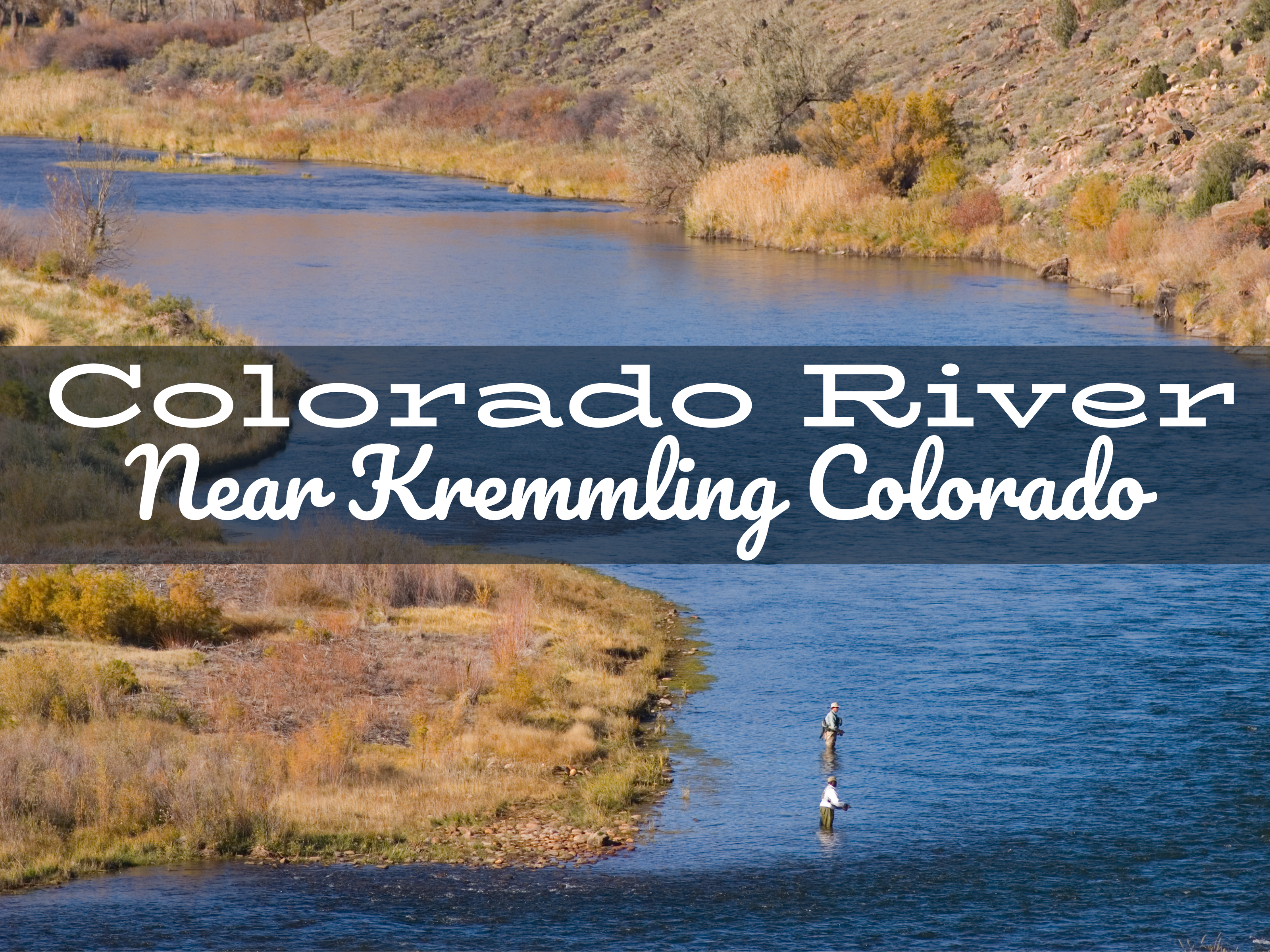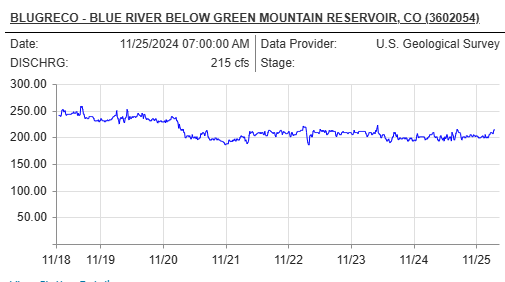.png?width=2240&height=1260&name=Colorado%20Stream%20Fly%20Fishing%20Reports%20(32).png)
Blue River Fly Fishing Report Near Green Mountain: 10/21/2024
%20(2).png?width=800&height=175&name=Guide%20Rating%20(800%20x%20175%20px)%20(2).png)
Current River Conditions
The Blue River below Green Mountain Reservoir is in great shape this October, with solid flows and crystal-clear water that make it an ideal spot for some fall fly fishing. Trout are actively feeding, and with the cooler temperatures settling in, it's the perfect time to test out your nymphing skills or swing a few streamers for those more aggressive browns. The area below the reservoir offers some prime fishing opportunities with less pressure than the more popular stretches near Silverthorne.
Late mornings to mid-afternoon are where it’s at for the best action. The cooler mornings mean slower activity early on, but things heat up once the sun hits the water. Look for trout hanging out in deeper runs and along the banks, where they’re more than willing to snack on midges and BWOs. Keep an eye out for afternoon hatches that can bring trout to the surface, making dry fly fishing an exciting option for the day.
Flow Rate: 250-300 CFS
Water Temperature: 45-50°F
Clarity: Clear, with occasional debris from recent rains
Best Times: Late morning to mid-afternoon
River Flow Chart

For real-time data on river conditions, visit the Colorado Division of Water Resources.
-1.png?width=600&height=400&name=fly%20fishing%20in%20colorado%20(5)-1.png)
Hatches & Recommended Flies

Nymphs
- Zebra Midge (#20-24) – Effective throughout October as midges remain one of the most consistent food sources. Fish them deep in runs and pools, especially in the mornings when trout are feeding subsurface.
- RS2 (#20-22) – Perfect for afternoons when Blue Wing Olives (BWO) are hatching. Use this nymph in deeper runs and riffles where trout are actively feeding.
- Mysis Shrimp (#16-20) – Best used below Dillon Reservoir year-round, especially in October when other food sources are limited. Trout feed heavily on these shrimp, so nymphing with them in the tailwater section is highly productive.
- Black Beauty (#20-24) – Great for targeting trout feeding on midge larvae during mid-morning to early afternoon. Best used in slower runs and pools.
Dry Flies
-
Blue Wing Olive (BWO) (#18-22) – Effective on overcast days in October, as BWOs are prevalent. Use these during late morning to afternoon when the hatch peaks, and target rising trout in seams and eddies.
-
Parachute Adams (#18-22) – A versatile dry fly, ideal for afternoon fishing when trout are actively feeding on mayflies. Cast in riffles and slower-moving sections.
-
Griffith's Gnat (#20-24) – Best used during midge hatches in calm, clear water. Fish this fly in slower pools during the afternoon to target rising trout.
Streamers
-
Pat’s Rubber Legs (#8-10) – Fish these streamers early in the morning or late in the afternoon in deeper pools and near structure like undercut banks. Ideal for targeting larger, aggressive trout.
-
Sculpzilla (#6-10) – A solid choice for deeper waters and targeting larger trout. Strip or swing through pools during low-light conditions for the best results.
Access Points:
Silverthorne Outlet Section (Below Dillon Reservoir)
-
Description: Easily accessible right in the heart of Silverthorne, near the outlet stores. This section below the Dillon Reservoir is known for its large, finicky trout that feed on Mysis Shrimp. It offers consistent water conditions, but can be crowded due to its popularity.
-
Why Fish Here: Excellent year-round access to trophy-sized trout. Nymphing is highly effective here with Mysis Shrimp and small midges.
Blue River Campground
-
Description: Located near Green Mountain Reservoir, this area provides access to a quieter stretch of the river. The campground also offers overnight accommodations for anglers looking to fish multiple days.
-
Why Fish Here: Less crowded, with good access to deeper pools where larger trout often hold. Streamer fishing can be productive here, especially early in the morning.
Green Mountain Reservoir Tailwater
-
Description: A more remote but rewarding access point, located below Green Mountain Dam. It involves a bit of a hike, but the fishing here is worth the effort. The water flow is regulated, offering more predictable conditions.
-
Why Fish Here: Excellent for those looking for solitude and a shot at big trout in deeper water. Nymphing and streamer fishing are ideal in this section.
Blue River Below Silverthorne
-
Description: As you head downstream from Silverthorne, there are multiple access points along the river that provide great fishing opportunities with less crowding. The water picks up volume from tributaries, making it an ideal spot for targeting large trout.
-
Why Fish Here: A great area for anglers looking to avoid the crowds at the outlet section, with good opportunities for both nymphing and dry fly fishing.
Columbine Landing
-
-
Description: This is a quieter section of the Blue River, located further downstream. Known for big brown trout, it's a great spot to escape the crowds and focus on streamer fishing.
-
Why Fish Here: Ideal for fishing in relative solitude, with chances to land larger fish using streamers in deeper runs.
-
Fishing Tactics
Nymphing Techniques for the Blue River
The Blue River is no place for a lazy cast; nymphing here is your bread and butter. With its crystal-clear water, every presentation must be precise and stealthy. Set up with a small indicator, and be prepared to adjust based on depth. When the trout aren't showing interest on the surface, it's time to rely on your nymphing skills.
High-Sticking Nymphing: This is a killer technique for the Blue’s deeper runs and riffles. Keep a tight line with minimal slack to feel those subtle strikes. High-sticking is especially effective in the upper sections below Dillon Dam, where trout are holding in fast water.
Two-Fly Nymph Rig: Want to cover multiple depths? Start with a heavier attractor pattern like a Mysis Shrimp or Pat’s Rubber Legs as your point fly. Follow it up with a smaller, more imitative pattern like a Zebra Midge or RS2 as a dropper. This setup will target bottom-feeding trout and those cruising higher in the water column.
Adjust Depth and Weight: You’ll need to fine-tune your rig based on flow and water depth. Add enough split shot to get your flies down quickly into the strike zone, especially in the Blue’s deeper pockets. Use a drag-free drift to avoid spooking fish and use strike indicators to help detect subtle takes.
Dry Fly and Dry-Dropper Fishing
While the Blue is often dominated by nymphing, don’t neglect the potential for dry flies. When the hatches are on, trout will rise, and that's your opportunity. Blue Wing Olive (BWO) hatches in the fall offer prime dry fly opportunities. Pair a Parachute Adams or Griffith’s Gnat as your indicator fly with a small nymph like an RS2 hanging below for a versatile dry-dropper rig. Target seams and soft pockets where fish are likely to rise.
Streamer Fishing
Streamer fishing on the Blue River can be incredibly effective for landing larger trout. Cast streamers like Pat’s Rubber Legs or Sculpzilla into deeper pools or along undercut banks. Swing or strip them through the slower-moving sections to entice aggressive strikes. Early morning or late evening is prime time for streamers, especially when the water is clear, and trout are more likely to chase larger prey.
Sight Fishing and Stealth Tactics
The Blue River’s transparency demands a stealthy approach. Polarized sunglasses will help reduce glare, allowing you to spot trout in deeper pools or runs. Keep a low profile and use long leaders (9-12 feet) with light tippet (5x-6x) to reduce visibility. Approach the water with caution, and focus on subtle signs of fish activity like surface disturbances or bubbles.
.png?width=300&height=100&name=Copy%20of%20Rise%20Beyond%20Logo%2012.31.24%20(300%20x%20100%20px).png)
.png)
.png?width=1920&height=1080&name=Untitled%20design%20(48).png)


.png)